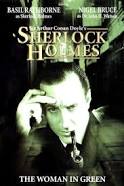
“We’re confronted with a series of the most atrocious murders since Jack the Ripper.”
A series of murders baffles the police, their fingers severed. Sherlock Holmes (Basil Rathbone) and Dr. Watson (Nigel Bruce) are enlisted to help. At first, Holmes is just as baffled as the police.
Sir George Fenwick (Paul Cavanagh) is a widower who after a romantic evening with Lydia Marlowe (Hillary Brooke) wakes up to find a woman’s finger in his pocket. He was hypnotized into thinking he murdered someone and is being blackmailed. He buries the finger in his back yard but his daughter digs it up and brings it the Holmes. Fenwick is killed to keep him from talking. Holmes believes it is the work of Moriarty (Henry Daniell). Moriarty confronts Holmes. He wants him to stop investigating. After Moriarty leaves Holmes notices something going on in the empty house across the street. He sends Watson to investigate.
Inside the empty house Watson sees a sniper shoot at what looks like a shadow of Holmes across the street. Holmes had placed a bust of Julius Caesar in front of the window as a decoy. When the sniper shoots the bust, Holmes grabs him. The sniper is found to be an ex-soldier that has been hypnotized. Holmes gives him to Inspector Gregson (Matthew Boulton). Later the sniper, still in a trance, is kidnapped and killed.
Holmes theorizes Moriarty's plan has several components. First is to kill women and cut off their fingers. Second hypnotize rich men and make them believe they are responsible for the murders. Third blackmail the men. All of this hinges on the men believing they did kill and that they are too afraid to expose the blackmailers. They choose men who are more afraid of having their reputations ruined than in paying blackmail money.
Holmes’ only link to the framed men and Moriarty is the woman Holmes saw with Fenwick the night he supposedly killed someone. Lydia is his way in, and possibly his path to death.
“The Woman in Green” was released in 1945 and was directed by Roy William Neill. This is the 11th in the series of 14 Sherlock Holmes movies that feature Basil Rathbone and Nigel Bruce as Holmes and Watson. It is the third and final appearance of Moriarty in the series of 14. And as in the last two movies, the accident prone evil villain dies again. Also, it is the second of the series to be in the public domain. There is also a colorized version of the film. In one scene Holmes is pressured to take a tablet of "Cannabis japonica" (a fictional species of marijuana invented by the screenwriters), ostensibly to relax his mind and make it easier for him to be hypnotized.
Someone remarked that in the scene, about nine or ten minutes into the film, with Lydia and Fenwick sitting on the couch, there is a statue that casts a phallic-looking shadow on the wall behind them. I’m not sure if it is something that slipped past the censors or if it is a coincidental symbol merely in the eye of the beholder.
Although he is not seen, the only reference to Mycroft Holmes in the Basil Rathbone / Nigel Bruce series is made in this film. Mycroft is seven years older than Sherlock. He is the only character to refer to Sherlock exclusively by his first name. Mycroft’s deductive powers exceed even those of his brother; however, he is incapable of performing detective work like Sherlock as he is unwilling to put in the physical effort necessary to bring cases to their conclusions. He’s lazy. Mycroft works for the British government. While Doyle's stories are unclear what Mycroft’s exact position is in the British government, Sherlock Holmes says that "Occasionally he IS the British government, the most indispensable man in the country." He seems to serve as a sort of human computer.

